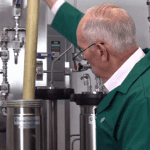Tuning the Orchestra in Cannabis Extraction
Supercritical fluid extraction mechanics are derived from the pressurization of a fluid under subcritical or supercritical conditions, applying heat, then moving the fluid into an extraction vessel where the desired cannabis constituents are separated, isolated and collected. The separation mechanics are controlled by changing temperature and pressure, as each compound reacts differently and has a different degree of solubility to the operating conditions. Solubility, density and processing time are essential factors in the recovery of a specific compound.
One of the key aspects of using pure supercritical CO2 or CF3CH2F as the extraction solvents are their unique properties in the supercritical phase, providing a level of tunability that can be achieved more easily than other solvent choices. Supercritical CO2 and CF3CH2F have been proven to be inexpensive, recyclable and environmentally safe industrial solvents that have been successful in the extraction processes used for coffee, vanilla, tea, omega-3 oils, fragrances, and others. By altering the pressure and temperature conditions during the extraction, the operator can change the solvent characteristics of the CO2 and/or CF3CH2H providing the ability to extract only the compounds of interest.
When I talk about tunability, I like to use an analogy of an orchestra. The conductor (method developer) can organize the musicians (cannabis components) and ask them to leave the room (extraction) in sections upon request. So, for example, if ethanol, which has less tunability at room temperature, is used as the extraction solvent, the conductor could only ask the musicians to leave the room altogether. With CO2, however, the conductor could ask the string section to leave the room, then the percussion, then the brass section and so on. Upon leaving, the conductor could even ask them to overlap a bit providing the ability to test different interactions between the musicians (components), with the ultimate goal of getting the entire orchestra to play in sync.
The conductor has to also assess the unique attributes of each group. For cannabis extraction, those important attributes are:
Impact of moisture – too high a moisture level (higher than 8%) will result in CO2 acting as a co-solvent and removing polar compounds, or if too little, will result in reducing the compounds being less amenable to extraction. Water plus CO2 will result in a lower pH due to carbonic acid. CF3CH2F will not have this effect.
Particle size – the grinding process should result in controlled, reproducible particle sizes to ensure repeatable methodology. Too small particles will often result in channeling and clumping of the material and too large will make the interstitial distance too far apart, and the CO2 would have to travel too far and reduce the total amount of extracted material and at too slow a rate.
Mass balancing – need an accurate determination of the cannabinoid and terpene content of the starting raw feedstock material, the CO2 concentrate and what was left behind, as this material could be used in other products, like cosmetics.
With all of this knowledge on hand, the conductor can keep his orchestra in sync and deliver the most pleasing sound. And, the extraction method developer can provide the highest quality end product.
Recent Posts





